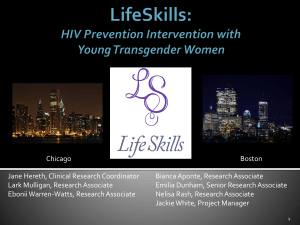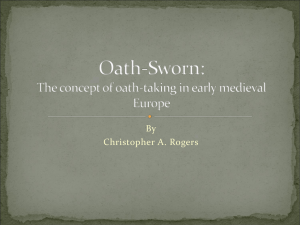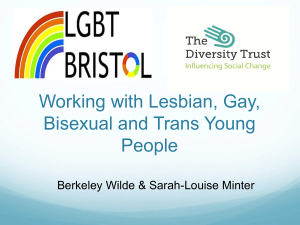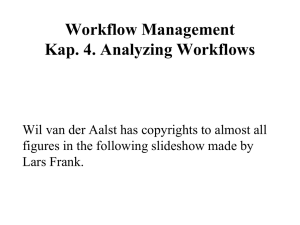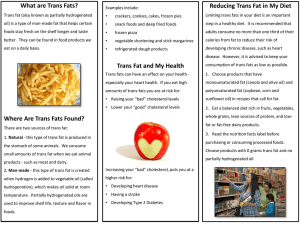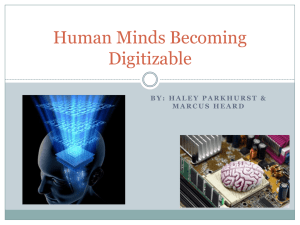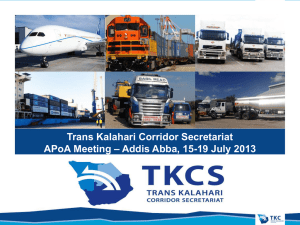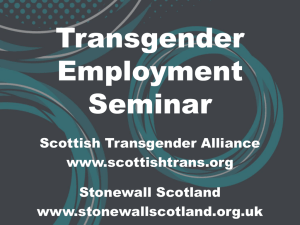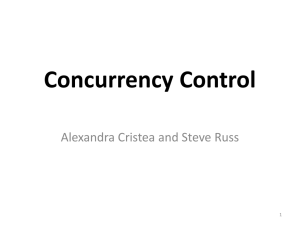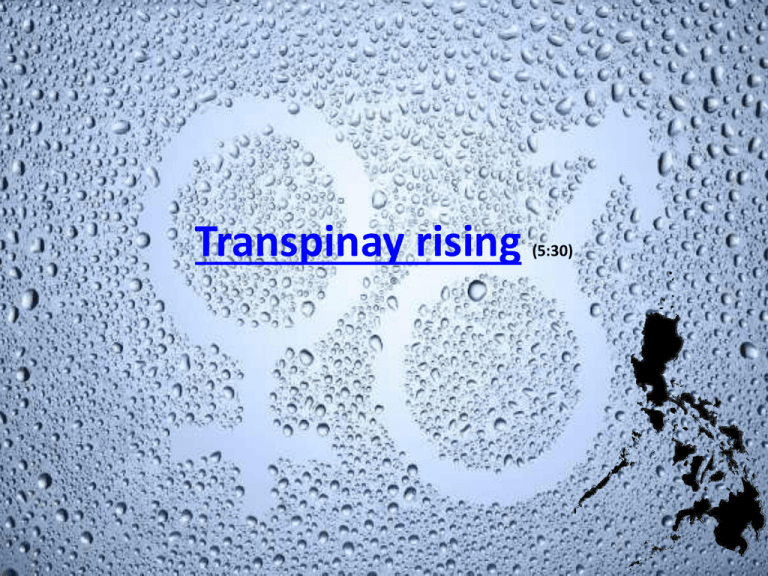
Transpinay rising
(5:30)
Being trans* in the Asia-Pacific:
trans* rights, trans* health,
trans* pride
Sam Winter,
Hong Kong
Pieter Breughel.
Hunters in the Snow
(1565)
Philip II of Spain etc..
1527-1598
Lord of the Seventeen
Provinces 1556-1581
The Dutch Revolt
1566- or 1568 - 1648
Miguel Lopez de
Legazpi
Intramuros,
Manila
Intramuros,
Manila
Sexuality and gender in the islands
• Unfamiliar sexual and gender values:
– Men and women “chieftains”
– Virginity not valued
– Adultery not punished
– Widespread “sins against nature”, “unnatural acts”
• Unfamiliar beliefs and religious roles
– Animism
– Female shamans
• baylan, catalonan
• mediating, placating, foretelling,
• healing, arbitrating.
– “Trans” shamans
• bayog, bayoc, asog
• Cross-dressing, braided hair,
• social roles
• sexual roles
Miguel de Benavides
Archbishop of Manila,
1605
Ignacio de Santibanez,
Archbishop of Manila,
d.1598
Felip Pardo,
Rector UST,
d.1689
Francisco Ignacio Alcina (1668)
History of the Bisayan Islands.
(Writing about ‘ancient times’….)
“The fact is the asog considered themselves more like
women than like men in their manner of living, or going
about, or even in their occupations. Some of them
applied themselves to women’s tasks, like weaving and
cultivating etc. In dress, although they did not wear
petticoats (these were not worn by women in ancient
times either) they did wear some lambon, as they are
called here. This is a long skirt down to the feet, so that
they were recognised even by their dress.”
Munoz text, translated by Leitz,PS., cited in Brewer,C. (1999).
1565
1542
1557
1510
1511
1511
1514
1624
1619
“Trans” dancers, singers, musicians, actors,
spirit mediums, healers,
teachers etc.
Japan,
China, Korea,
Myanmar, Laos, Thailand,
Indonesia, Oman, Pakistan, Bangladesh,
Afghanistan
India
Philippines
Siberia
Pacific Islands
(Okinawa, Hawai'i, Samoa, Tonga, Tuva etc)
.
Gender pluralism
(Peletz,M, 2006)
= “…pluralistic sensibilities and dispositions regarding bodily
practices (adornment, attire, mannerisms) and embodied
desires, as Categories
well as social
roles, sexual
relationships
recognisable
to us
as genders,and
ways of being
that
bear
on
or are
otherwise
linked with
based
more
on
social
and
sexual
behaviours
local conceptions of femininity, masculinity, androgyny etc.
than on biological maleness and
….[pluralism] transcends and must be distinguished from
femaleness,
and
whose
members
were
dualism in that
more than
two
principles,
categories,
of their
societies.
groups etc arevalued
usuallymembers
at stake and
accorded
legitimacy (not
simply principles constituting categories of
heteronormative female-bodied individuals and their malebodied counterparts. ..(S)exual pluralism,,,is included under
the more encompassing rubric of gender pluralism” (p310)
Peletz (2006) Transgenderism and gender pluralism in Southeast Asia
since early modern times. Current Anthropology 47, 2, 309-340
Francisco Ignacio Alcina (1668)
History of the Bisayan Islands.
(Writing about a native islander he knew…).
[This man] “is so effeminate in every way that he seemed
more like a woman than a man…. His dress was even over
the legs with a wide bahaque which resembled, under the
lambon, the old time petticoats. All the things that the
women did, he performed, such as weaving blankets,
and sewing clothes, making pots, which is the work
of [women]. He danced also like they did, never like a
man whose dance is different. In all he appeared more
a woman than a man.”
Munoz text, translated by Leitz,PS., cited in Brewer,C. (1999).
bakla (man-woman)
(=‘babae-lalake’, or ‘babae-akala’)
also binabae (like a woman)
bayot, bading etc..
denoting effeminate “gay” men and
trans people.
“Despite Catholicism - with its own
sacramental frocks worn by its ‘men
of the cloth’ – and three hundred
years of Spanish colonial rule, crossdressing, effeminacy and gender
transitive behaviour never really
disappeared in Philippines society.”
Crispulo
‘Pulong’
Luna
(1903-1976)
Garcia, JN (2004)
Male homosexuality in the Philippines:
a short history. IIAS newsletter, 35
w
Colonisation
w
Christianisation
“Trans” as..
“unnatural”
“contradicting
God’s will”
w
Modernisation
“sexually
deviant”
“deceptive”
w
Globalisation
“sick”
w
Industrialisation
w
Westernisation
• Transpeople in the Asia-Pacific today
– I estimate around 9 - 9.5 million trans* people in AsiaPacific? (15 – 15.5 million worldwide?)
• (@0.3% for 15+)
• - see a paper by Winter and Conway on the TransgenderASIA
website
– A-P trans HIV prevalence rates to 49%. Other STIs high.
– Commission on AIDS in Asia (2010) - By 2020 trans*and
MSM will together constitute majority of new HIV
infections
– A health issue, a rights issue, a development issue
United Nations Development Programme
‘Transgender persons, human rights and
HIV vulnerability in Asia and the Pacific.’
• Transgender people:
– Individuals whose gender identity and/or
expression of their gender differs from social
norms related to their gender of birth. The term…
describes a wide range of identities, roles and
experiences which can vary considerably from one
culture to another’
• Trans* people
‘Transgender persons, human rights and
HIV vulnerability in Asia and the Pacific.’
– Commissioned by UNDP May 2011
– In response to calls from trans groups for more trans
research
– ‘Desk review’
– Review reviewed by trans group leaders and others
– Publication due May 2012 (IDAHOT Day)
‘Transgender persons, human rights and
HIV vulnerability in Asia and the Pacific.’
• Aims:
– To examine laws, regulations, policies and practices that
prompt, reinforce, reflect or express stigma and prejudice
towards trans* people
– To identify vulnerabilities to HIV and barriers to access
or uptake of HIV-related healthcare services, and:
– To establish a research agenda aimed at providing the
sort of data that will enable a reduction in future risk, as
well as better access to treatment, care and support for
transgender persons living with HIV.
‘Transgender persons, human rights and
HIV vulnerability in Asia and the Pacific.’
A broad-brush picture of what the
research shows
To the margins of society
• Family and school
– dropping out and leaving home
To the margins of society
• Family and school
– dropping out and leaving home
86 known murders Jan08-Dec11
• Wider society
TGEU Trans* Murder Monitoring
– employment, housing, health services, access toProject
public spaces.
Verbal abuse, violence (incl. sexual), murder.
To the margins of society
• Family and school
– dropping out and leaving home
• Wider society
– employment, housing, health services, World
, access
public35000
spaces .
Bankto
estimates
trans* female sex workers in
Verbal abuse, violence (incl. sexual), murder.
Pakistan; around fifth of all sex
– drift towards ‘ghetto’ employment
workers.
To the margins of society
• Family and school
– dropping out and leaving home
• Wider society
– employment, housing, health services, access to public spaces.
Verbal abuse, violence (incl. sexual), murder.
– drift towards ‘ghetto’ employment
• Government
– documentation: ID cards,
To the margins of society
• Family and school
– dropping out and leaving home
• Wider society
– employment, housing, health services, access to public spaces.
Verbal abuse, violence (incl. sexual), murder.
– drift towards ‘ghetto’ employment
• Government
– documentation: ID cards,
– documentation: legal gender recognition
To the margins of society
• Family and school
– dropping out and leaving home
• Wider society
– employment, housing, health services, access to public spaces.
Verbal abuse, violence (incl. sexual), murder.
– drift towards ‘ghetto’ employment
• Government
– documentation: ID cards,
– documentation: legal gender recognition
– lack of protection against discrimination
Trans-relevant rights in ICCPR, ICESCR, CRC ?
All following apply to all people without distinction of any kind, such as …. or any
other status (ICCPR 2, ICESCR 2, CRC 2):
Freedom from: school discipline damaging to dignity (CRC 28), degrading
treatment or punishment (ICCPR 7, CRC 37), arbitrary arrest or detention
(ICCPR 9), interference with privacy (ICCPR 17, CRC 16) or attacks on
reputation (CRC 17);
Rights to: education directed to full development of personality (ICESCR 13, CRC
29); expression (ICCPR 19, CRC 13), marriage (ICCPR 23), work (ICESCR 6) equal
opportunity for promotion (ICESCR 7) adequate standard of living (ICESCR 11);
Protection against discrimination on any ground such as ,,,,, or any other status
(ICCPR 26)
and CRPD? CEDAW?
To the margins of society
• Family and school
‘Imitating /impersonating the other sex’
Afghanistan, Samoa,
– dropping out and leaving home e.g. Malaysia,
Tonga, Kuwait …
• Wider society
– employment, housing, health services,
access
to public
spaces.
Engaging
in ‘same-sex’
behaviour.
e.g.murder.
Malaysia, Bangladesh, Pakistan,
Verbal abuse, violence (incl. sexual),
PNG, Samoa, Tonga etc
– drift towards ‘ghetto’ employment
• Government
Doing sex work where it
is criminalised
– documentation: ID cards,
e.g. Pakistan, Laos, Cambodia, China, Thailand etc.
– documentation: legal gender recognition
or is regulated.
India, Malaysia, Singapore, Hong Kong etc
– lack of protection against e.g.
discrimination
– criminalisation of gendered and sexual behaviour
To the margins of society
• Family and school
– dropping out and leaving home
• Wider society
– employment, housing, health services, access to public spaces.
Verbal abuse, violence (incl. sexual), murder.
– drift towards ‘ghetto’ employment
• Government
– documentation: ID cards,
– documentation: legal gender recognition
– lack of protection against discrimination
e.g. Bangladesh, Nepal, Kuwait, India,
Uzbekistan,
Kyrgyzstan, Sri Lanka,
– criminalisation of gendered and sexual
behaviour
Thailand, Cambodia, Iraq, Turkey etc.
– police harassment, violence
The Stigma-Sickness Slope
Stigma
Harassment
+ Abuse
Prejudice +
Violence
Discrimination
Marginalisation
Poverty
(social, economic,
legal)
Poor physical /
Risky
emotional
situations + Sex work
well-being
behaviours
Sickness
Inadequate
health care
Death
HIV/AIDS
Trans* action in Asia
Trans* action in action
• Coming out, speaking up
– eg SGDS
• Organising locally, coming out from under the GLB umbrella
- eg STRAP(M/C), COLORS; TEAM, GC, TGR; TTA, TAT
• Establishing identities separate from GLB
– eg Kwan sing bit yan si; khon khaam phet; mak-pak-nyah;
transpinay/transpinoy Pat Bringas, Miss Malaysia
• Working on on local and national health and rights issues
– eg STRAP: discrimination; anti-discrimination legislation
– eg TGR: gender recognition (marriage rights; ID); training for health
professionals; information booklet
• Reaching out further
– eg STRAP (SGDS); TGR (in China)
• Linking up regionally and internationally
– eg APTN; APCOM, GATE; UNDP, UNAIDS, WHO; CONGENID, ICAAP; UN
• Speaking out on international issues
– HIV/AIDS, sex worker rights, health information, health rights, research needs
– Diagnostic reform (APTN, STRAP)
• Bringing in the trans*men
– STRAP, TGR, APTN
‘Transgender persons, human rights and HIV
vulnerability in Asia and the Pacific’ :
Recommendations for research that:
• ends the invisibility of trans*people
• avoids cisgenderism
• involves trans* people as research partners
•
•
•
•
counts trans*people (to make them count)
documents and understands trans* vulnerabilities
moves from risk to resilience
helps empower trans* people (through their CBOs and NGOs) to
– promote trans* positive attitudes and practices
– promote a trans* rights culture, making equality legislation work
– get health information out to trans* communities
– promote trans* positive, competent, comprehensive, accessible
healthcare.
Thank you
:
sjwinter@hku.hk
Websites
http://web.hku.hk/~sjwinter/TransgenderASIA
http://web.hku.hk/~sjwinter/General
Transpinay rising
(5:30)


